Families For Life | Mini Marriage PREP Tips: Speaker-Listener Technique
Failure to Communicate
Miscommunication is common in relationships. Sometimes what you think you are saying isn’t the message your partner receives. When this happens, it may be due to “filters” getting in the way. For example, in an air purifier, the dirty air passes through a filter. The filter blocks the dirt so that only clean air passes through. The filter changes the air.
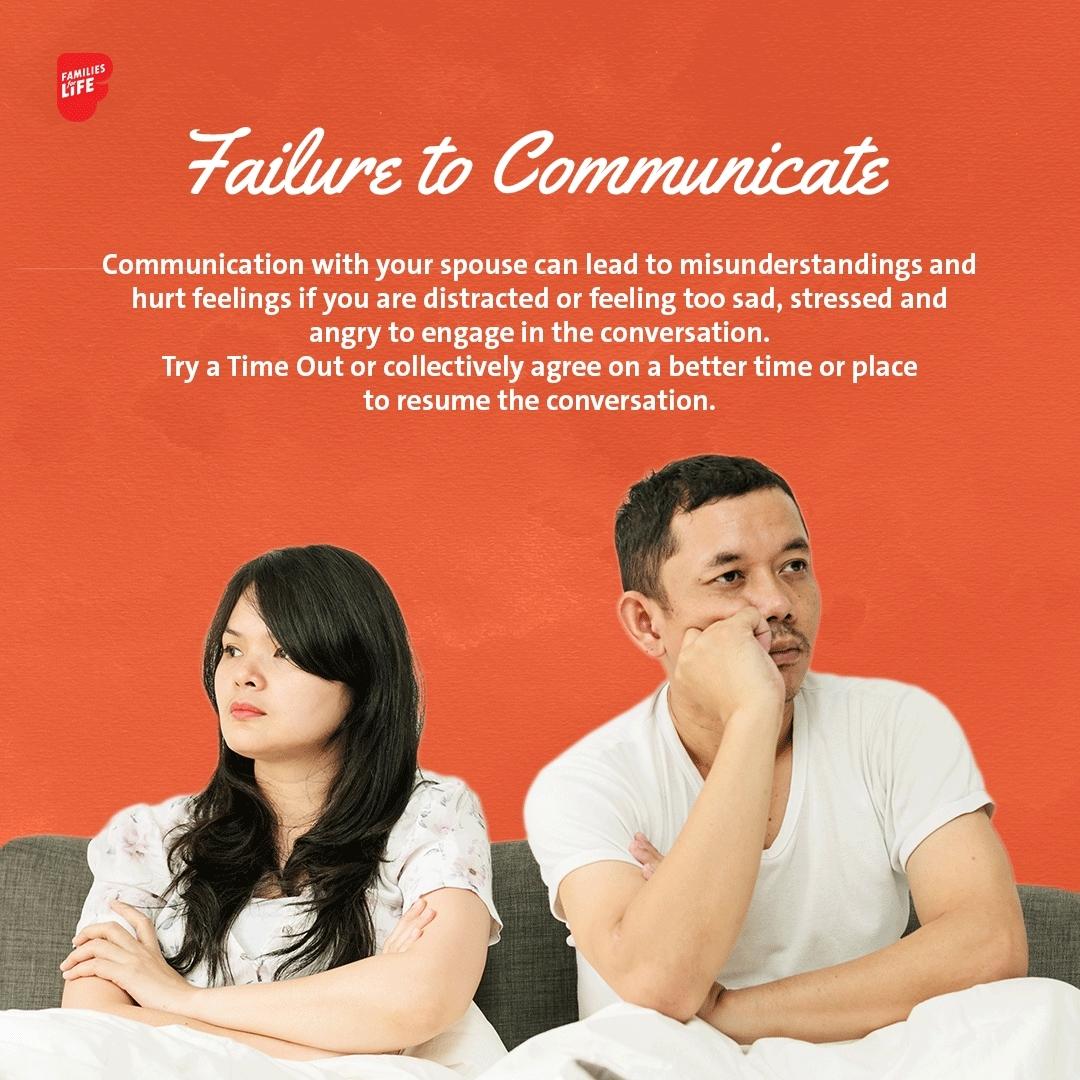
Similarly, when Communication Filters are at work, outside factors can distort or block our intended messages. For instance, if we’re distracted by our gadgets, if we’re speaking too quickly or softly for our partners to process, or we’re too sad, stressed, or angry to really engage in the conversation, our communication gets distorted, and can cause misunderstandings and hurt feelings . If we sense there are too many distractions or barriers to good communication, mention that to your partner, and if need be, agree on a better time/place to resume the conversation.
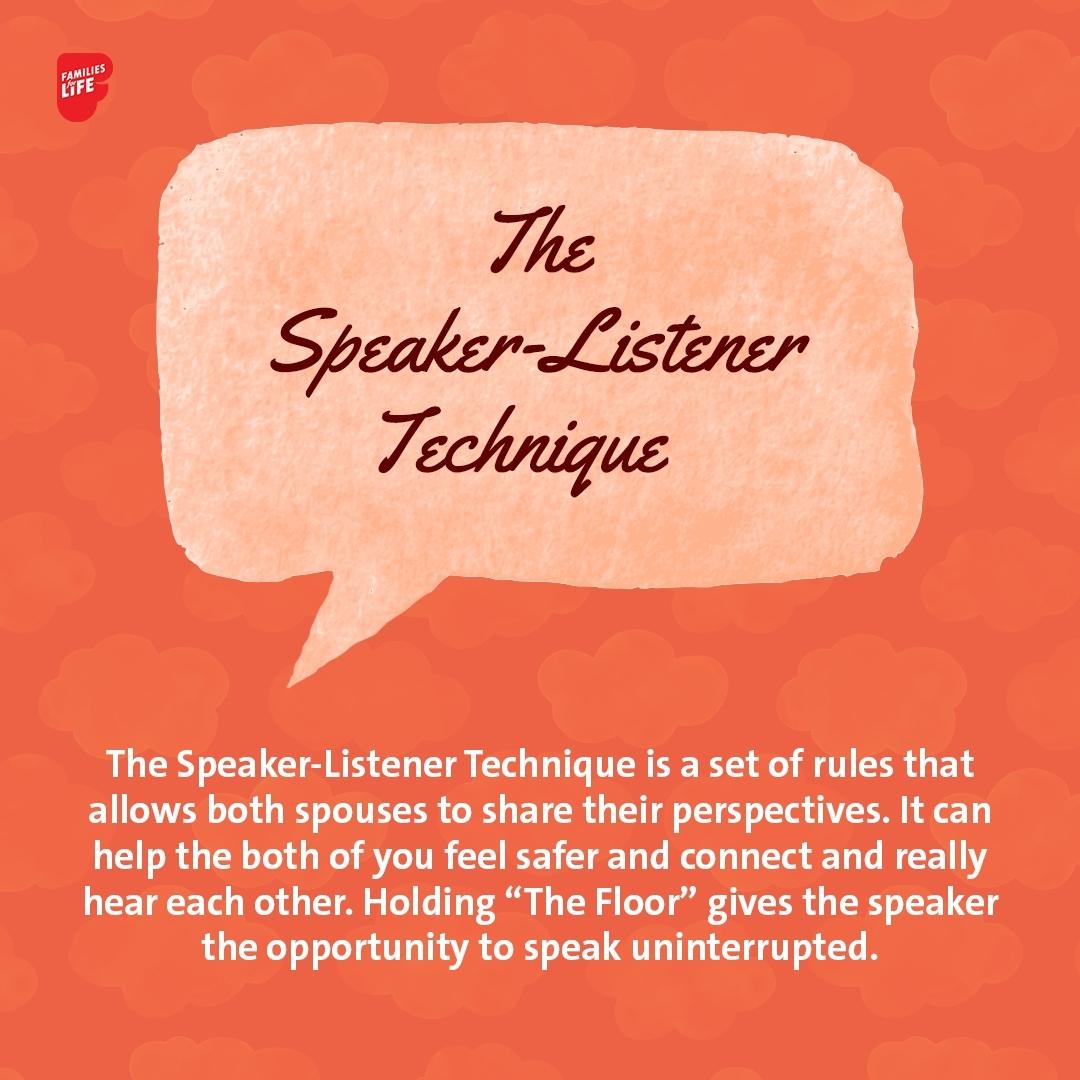
The Speaker-Listener (make it safe to connect; talk without fighting)
The Speaker-Listener Technique is an effective tool to help couples talk without fighting. The Technique is a set of rules that ensures each person gets a chance to speak their views; and that what is being said is accurately heard. To keep the conversation on track, the person holding “The Floor” will direct the conversation. “The Floor” can be any object to indicate that it is their turn to speak uninterrupted, but we recommend “The Floor Card,” which is a card with the rules of the Speaker-Listener Technique printed on it.
These rules help counteract barriers to good communication, like the Danger Signs (Escalation, Invalidation, Withdrawal, and Negative Interpretation). When you need to bring up a sensitive subject like finances, parenting differences, or your in-laws, the structured approach of the Speaker-Listener Technique can help you both feel safer, so you can connect - even on the tough stuff - and really hear each other. While the Speaker-Listener Technique can take a bit of practice, the process gives both partners a platform to share their perspectives and validate one another. To learn more about tips like these, why not sign up for a marriage programme?
Rules for Speaker-Listener Technique
Rules maintain order. Whether we’re playing sports, or getting behind the wheel of a car, rules keep us safe by making sure our actions and behaviors are focused towards a specific common goal.
The rules of the Speaker-Listener Technique protect the relationship by making sure a conversation stays on track. This technique also ensures that each of you has a chance to share your views and that the message is correctly received. If Communication Danger signs begin to show up when using the technique, make sure to use the Time Out rule to keep the intensity at a productive level.
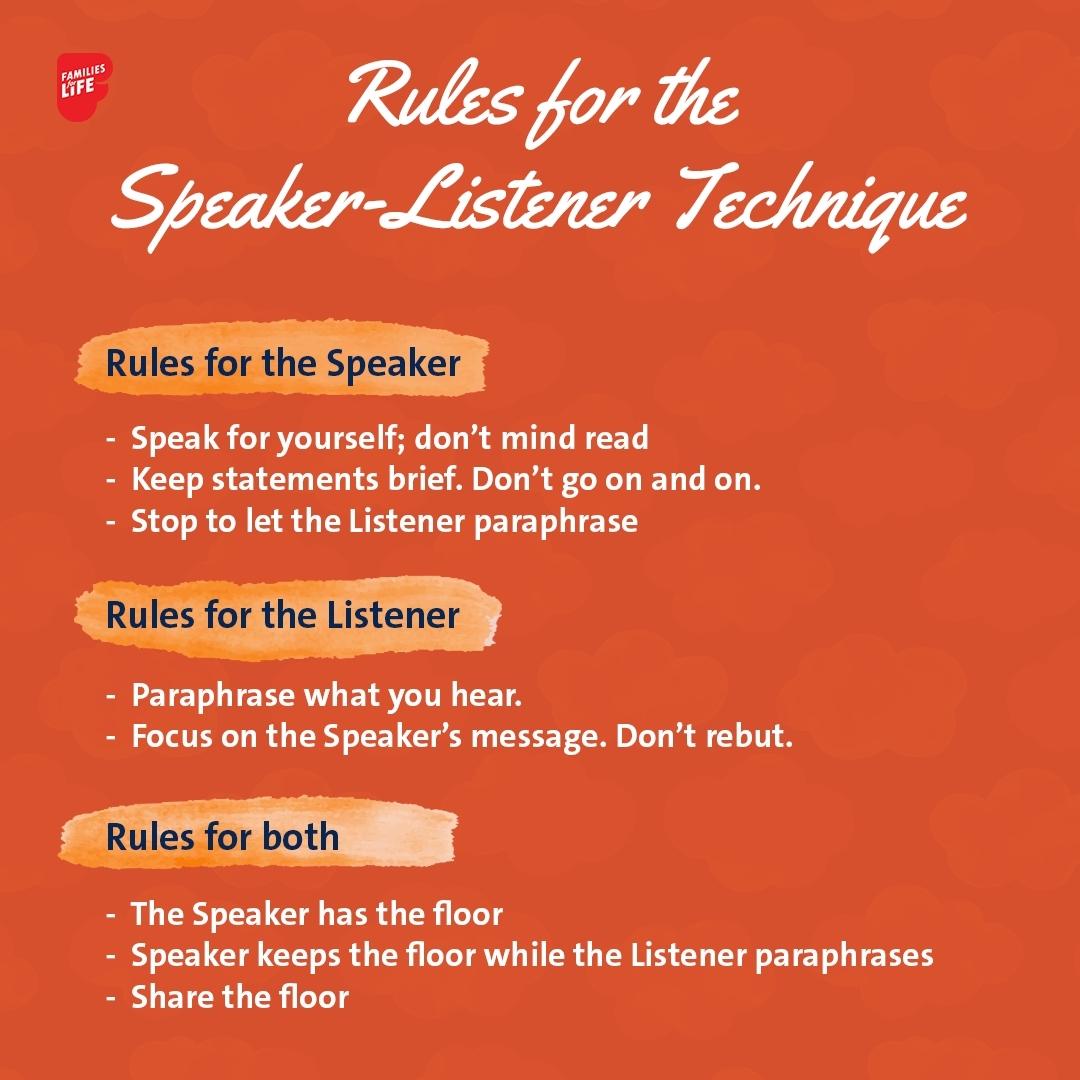
Rules for the Speaker
You are holding “The Floor” (your turn to speak uninterrupted). Make sure you’re speaking for yourself and not making assumptions about your partner. Avoid words like “you feel” or “you think”, and use words like “I feel” and “I think”.
Keep statements brief and pause often so your partner can restate in their own words what they heard you say.
Rules for the Listener
Listen carefully so you can accurately paraphrase the Speaker’s message.
Your responsibility is to understand the message. Do not argue or refute what is being said.
Rules for Both
The person holding “The Floor” designates whose turn it is to speak.
The Speaker keeps “The Floor” until they are done speaking.
Share “The Floor” so you both have a chance to speak and say what you need to say.
While the rules are fairly simple, they can be tricky to follow in the heat of the moment! So remember: the better you follow the rules of engagement, the more clarity and connection you’ll feel as you work through issues together.
Practise The Speaker-Listener Technique
If you want to try the Speaker-Listener Technique with your partner, start small – silly even. Share your views on your favorite movies, hobbies, bands, foods, or sports teams.
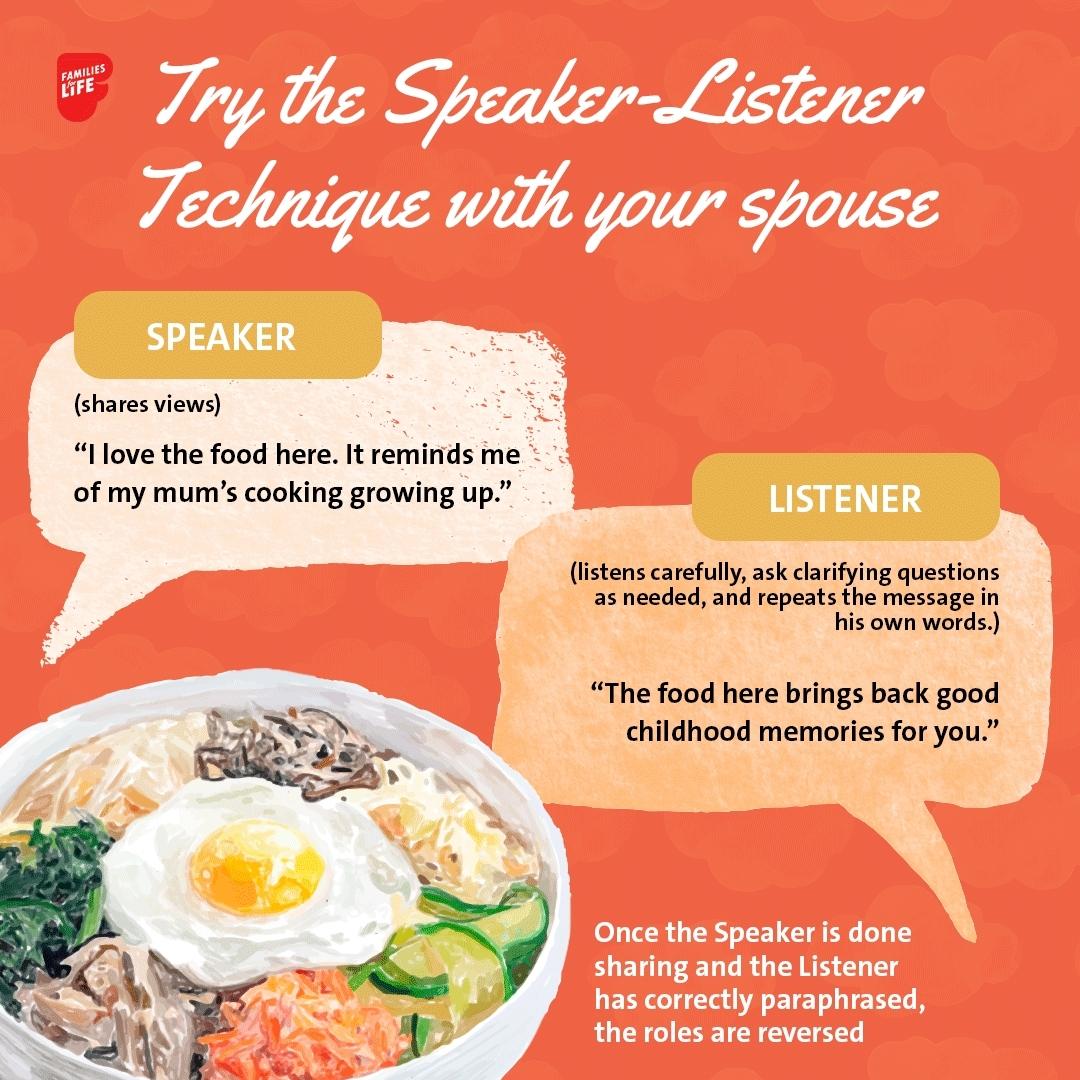
For example: The Speaker starts with “The Floor” (their turn to speak uninterrupted) and would like to share their favorite restaurant and what makes it special:
“I really love the food here. It reminds me of my mum’s cooking and the dishes we would have on special occasions growing up.”
The Listener should listen carefully, ask clarifying questions as needed, and offer a paraphrase. For example:
“The food here brings back good childhood memories for you.”
The paraphrase ensures that the message is clearly received. Once the Speaker is done sharing and the Listener has correctly paraphrased, the roles are reversed. “The Floor” is passed to the Listener and they become the Speaker. When you start with a “friendly” topic, it’s easier to practice the skill before applying it in a more intense situation. This technique will help you keep a conversation productive and on topic.
Benefits of The Speaker-Listener Technique

A benefit of using the Speaker-Listener Technique is that it slows down the pace of the conversation. You might be thinking, “Why would I want to slow a difficult conversation down? I just want to get it over with!” That sounds reasonable, but in reality, difficult conversations often come up again and again because they are never fully resolved. By slowing the conversation down, discussions are less likely to escalate into full-blown arguments or standoffs. That way, we prevent unintended and unproductive outcomes.
Often, we don’t even remember why the argument began or how much we have digressed from the original topic! By discussing one issue at a time and paraphrasing frequently, neither partner dominate the conversation. This gives both of you the chance to really hear one another, and for both partners to have ample time to think and respond without one partner steamrolling the other. Turn-taking and active listening are built into the process, which helps neutralise some of the bad communication dynamics couples tend to fall into. If we often assume the worst or have a habit of twisting words, paraphrasing will correct a lot of that on the spot. Similarly, if you tend to withdraw when things get too heated, the slower pace can help both of you feel safer, and keep the conversation open and productive, even if you’re upset.
Techniques for Handling Difficult Communication
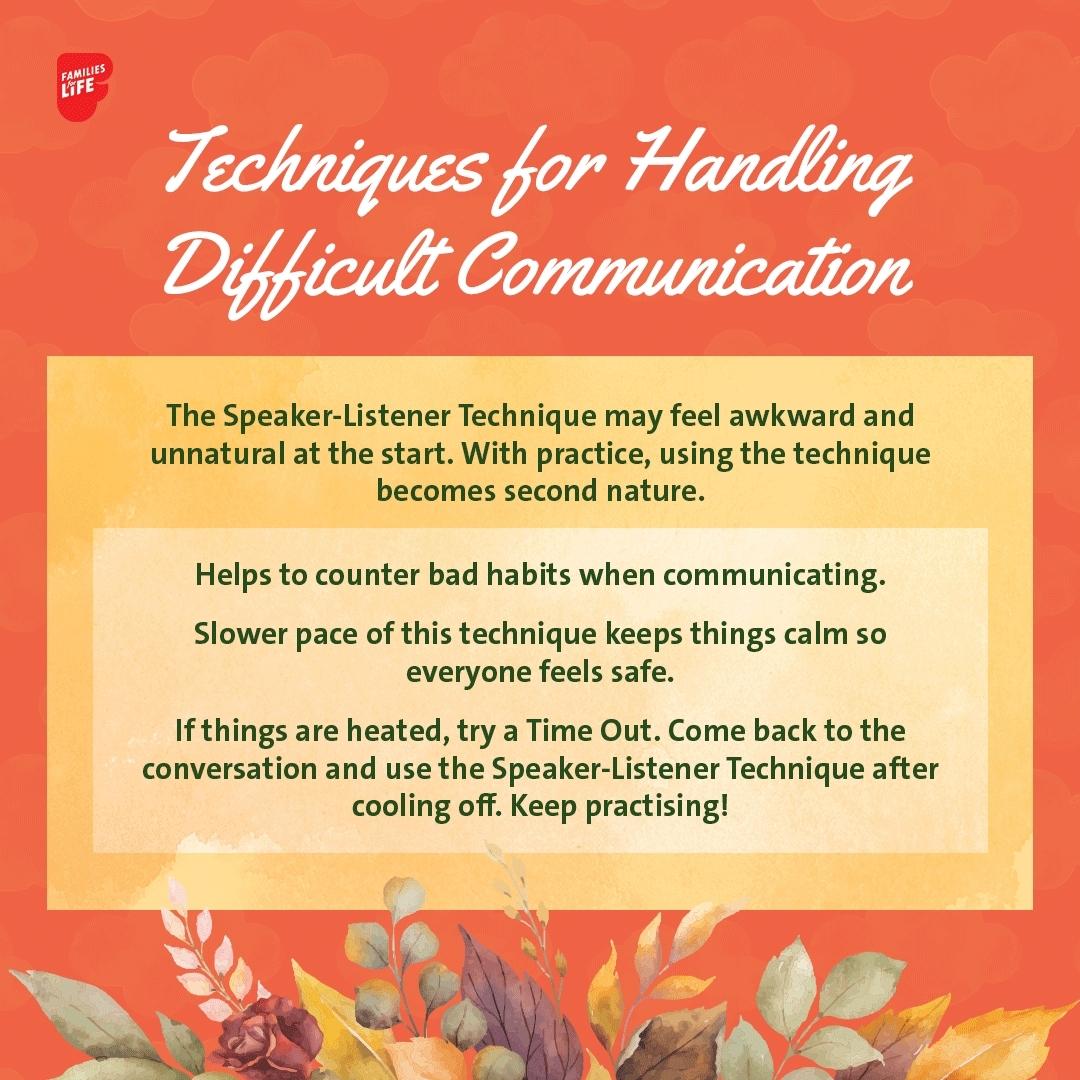
Couples who have been exposed to the Speaker-Listener Technique often say that it feels awkward and unnatural at the start. Admittedly, this is somewhat by design! Unfortunately, not all couples are able to handle disagreements or difficult topics in a healthy and productive manner. This technique helps to counter bad habits when communicating. The slower pace of this technique can really help keep things calm so everyone feels safe. Taking turns and repeating key points may feel a bit like play acting, but once mastered, couples have reported that using the technique becomes second nature. If things are really heated, try a Time Out first. Come back to the conversation utilising the Speaker-Listener Technique after you both have had a chance to cool off. This is why it is important to practise!
Practise Time Outs and the Speaker-Listener Technique so you have these skills in your toolkit when you need them the most.
If you like what you read, check out other mini marriage PREP tips here!